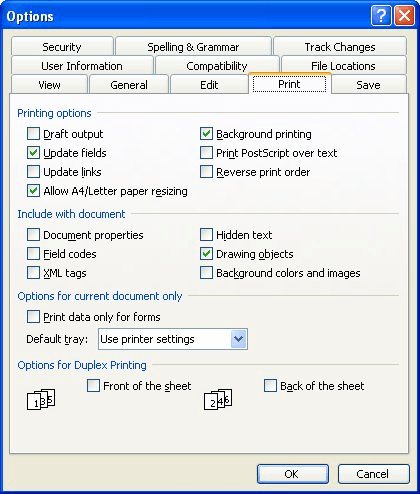Please Note: This article is written for users of the following Microsoft Word versions: 97, 2000, and 2003. If you are using a later version (Word 2007 or later), this tip may not work for you. For a version of this tip written specifically for later versions of Word, click here: Two Printed Copies to Different Paper Trays.
Joyce has a printer that has two paper trays in it. The first (default) paper tray contains regular white paper. The second paper tray contains a different color of paper. In Joyce's office, whenever they print documents they need to print one copy on white paper and the other copy on the colored paper. She wonders if there is a way to do a single print of the document, but have Word send one copy to the first paper tray and the other copy to the second.
The best way to do this is to use a macro, but there are a couple of different approaches you can use when creating the macro. I'm a firm believer in trying the easy way first, so you might try the following short macro:
Sub PrintTwoTrays()
Dim sTray As String
sTray = Options.DefaultTray
Options.DefaultTray = "Tray 1"
Application.PrintOut FileName:=""
Options.DefaultTray = "Tray 2"
Application.PrintOut FileName:=""
Options.DefaultTray = sTray
End Sub
This macro uses the DefaultTray property to specify a tray to use for your printer. This approach sets the setting you can see on the Print tab of the Options dialog box. (See Figure 1.)

Figure 1. The Print tab of the Options dialog box.
Note the Default Tray drop-down list on the dialog box. This lists the various tray options available for your printer. For most printers, there will be a Tray 1 and Tray 2 option, provided the printer has at least two paper trays. The PrintTwoTrays macro sets the option explicitly to Tray 1, prints a copy, then Tray 2, prints a copy, and then sets the setting back to its original value. If you look at the control in the dialog box and you see different options there, you can change the macro to reflect the appropriate options for your system—just make sure you use the exact wording shown in the drop-down list.
If the simple approach doesn't work, then you'll want to use the more detailed method. This involves setting up two different printer definitions, each of which utilizes a different printer tray. You'd need to define these printers in Windows, and you'll want to make sure that when you print a test page (again, in Windows), it utilizes to the desired paper tray.
At this point you have multiple printer definitions set up, and each will print to a different paper tray on the same printer. You can now specify the desired printer, in a macro, so that the printout goes to the desired paper tray.
Sub PrintTwoTrays()
Dim sCurrentPrinter as String
sCurrentPrinter = Application.ActivePrinter
Application.ActivePrinter = "Tray 1 Printer"
Application.PrintOut FileName:=""
Application.ActivePrinter = "Tray 2 Printer"
Application.PrintOut FileName:=""
Application.ActivePrinter = sCurrentPrinter
End Sub
You'll obviously want to change the printer names in the macro to reflect the names you assigned to the newly created printer definitions.
Note:
WordTips is your source for cost-effective Microsoft Word training. (Microsoft Word is the most popular word processing software in the world.) This tip (10644) applies to Microsoft Word 97, 2000, and 2003. You can find a version of this tip for the ribbon interface of Word (Word 2007 and later) here: Two Printed Copies to Different Paper Trays.

Do More in Less Time! An easy-to-understand guide to the more advanced features available in the Microsoft 365 version of Word. Enhance the quality of your documents and boost productivity in any field with this in-depth resource. Complete your Word-related tasks more efficiently as you unlock lesser-known tools and learn to quickly access the features you need. Check out Microsoft 365 Word For Professionals For Dummies today!
Endnotes are easy enough to add and accumulate in a document. For this reason, Word makes it easy to jump from one ...
Discover MoreDo you like using ASK Fields in your documents to get information from the user but don't want Word to update the fields ...
Discover MoreWord automatically maintains a number of properties for each document you create. As part of those properties you can ...
Discover MoreFREE SERVICE: Get tips like this every week in WordTips, a free productivity newsletter. Enter your address and click "Subscribe."
There are currently no comments for this tip. (Be the first to leave your comment—just use the simple form above!)
Got a version of Word that uses the menu interface (Word 97, Word 2000, Word 2002, or Word 2003)? This site is for you! If you use a later version of Word, visit our WordTips site focusing on the ribbon interface.
Visit the WordTips channel on YouTube
FREE SERVICE: Get tips like this every week in WordTips, a free productivity newsletter. Enter your address and click "Subscribe."
Copyright © 2025 Sharon Parq Associates, Inc.
Comments